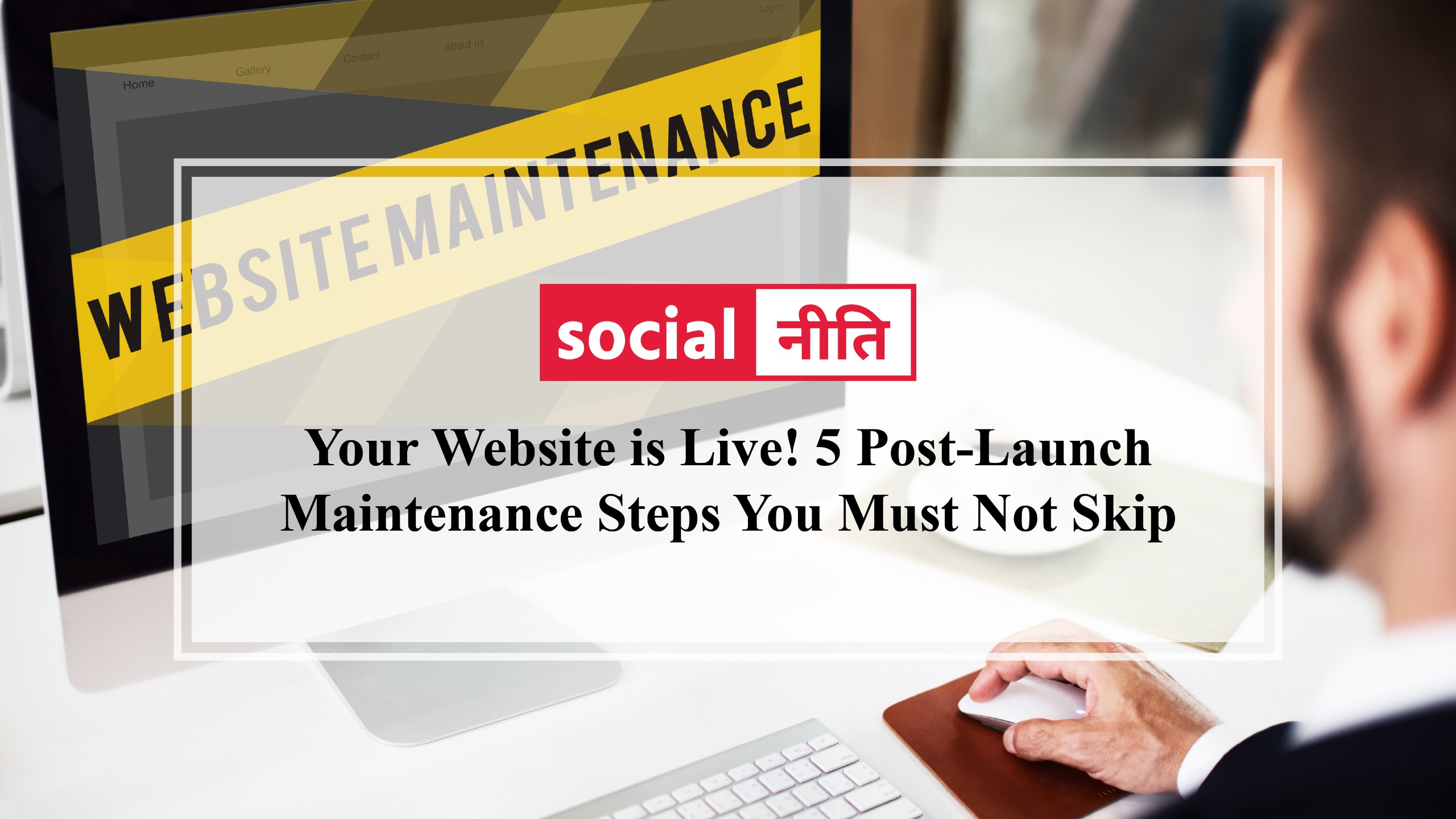Congratulations, your website is live! But the work doesn’t stop here. Just like a new car needs regular check-ups, your website requires ongoing attention to run smoothly. For many website owners, the post-launch phase is often overlooked, but it’s where the real journey of building a strong online presence begins. Consistent website maintenance ensures your digital storefront remains secure, fast, and appealing to visitors. Neglecting these steps can lead to poor performance and security risks, which is why professional support and website development services can be a lifesaver.
Understanding Website Post-Launch Steps
After your website’s launch, shifting your focus to website maintenance is the next logical step. This involves creating a solid maintenance plan that includes regular updates and checks to keep your site in top condition. Think of it as a roadmap for keeping your online platform healthy and functional.
A comprehensive website maintenance checklist should include essential tasks like security scans, content updates, and performance monitoring. Following a consistent routine ensures you cover all bases, from software updates to fixing broken links, safeguarding your digital investment for the long run. Many businesses rely on professional website development services at this stage to streamline the process.
Why Website Maintenance Matters After Launch
Have you ever landed on a slow or broken website? It’s frustrating, and you probably didn’t stick around. Regular website maintenance ensures your visitors have a positive first impression, which builds trust and encourages them to explore what you have to offer. A smooth, functional site is a direct reflection of your professionalism.
Your online presence is a vital part of your brand reputation. A well-maintained website signals reliability and quality to your customers. If your site is buggy or outdated, it can quickly tarnish the image you’ve worked so hard to build.
Ultimately, regular maintenance is crucial for your site’s performance and business growth. It helps improve your search engine rankings, keeps your site secure from threats, and provides a seamless experience for users. This leads to higher engagement, more conversions, and a stronger bottom line.
Common Misconceptions About Post-Launch Care
One of the biggest mistakes website owners make is thinking their job is done after the launch. The “set it and forget it” approach is a recipe for disaster in the ever-changing digital landscape. Regular website maintenance isn’t an optional extra; it’s a necessity.
Many believe that if a site is working fine today, it will work fine tomorrow. However, this overlooks the constant evolution of technology and security threats. Outdated content and a lack of security updates can leave your site vulnerable and irrelevant.
Here are a few common misconceptions about post-launch care:
- My website doesn’t need updates if it looks fine.
- Security isn’t a big deal for a small business site.
- Website maintenance is too expensive and time-consuming.
- My web host handles all the necessary maintenance.
Step 1 – Monitor and Update Website Content
Keeping your website’s content fresh and accurate is one of the most important maintenance tasks. Whether you’re adding new blog posts, updating product descriptions, or refreshing your homepage, consistent content updates signal to both users and search engines that your site is active and relevant. Many businesses use ongoing website development services to maintain this rhythm smoothly.
Importance of Fresh Content for SEO and User Experience
Search engines love new content. Regularly updating your site with fresh articles, case studies, or product information can significantly boost your search engine rankings. This makes it easier for potential customers to find you when they’re searching for products or services you offer.
Beyond SEO, fresh content is vital for a positive user experience. Imagine a visitor finding outdated information on your site, like an expired promotion or an old address. This creates a poor impression and can drive them away. Keeping everything current shows you care about your audience’s needs.
Consistently providing valuable and relevant information builds trust and positions you as an authority in your industry. When visitors see that your site is a reliable source of information, they are more likely to return, engage with your brand, and eventually become loyal customers.
How Often Should Content Updates Be Performed?
The ideal frequency for content updates depends on your website’s type and goals. A news site or a large e-commerce platform might require daily updates, while a small business site may only need weekly or monthly refreshes. The key is consistency.
Establishing a schedule for regular updates helps you stay on track. This could involve publishing new blog posts, updating event calendars, or performing a content audit to identify and remove outdated pages. A monthly website maintenance schedule is a great starting point for many businesses.
Mistakes to Avoid During Content Refresh
When you’re refreshing your content, it’s easy to make small mistakes that can negatively impact your site. One common error is forgetting to check for and fix any broken links. A broken link creates a dead end for your visitors and can harm your SEO performance.
Another mistake is neglecting your internal links. As you add new pages and update old ones, ensure your internal linking structure is logical and helps users navigate your site easily.
Avoid these common pitfalls:
- Leaving outdated content without removing or redirecting it.
- Forgetting to update meta descriptions and title tags.
- Not checking for technical issues like slow-loading images.
- Failing to promote new content across other channels.
Step 2 – Implement Robust Website Security Measures
In today’s digital world, website security is non-negotiable. Protecting your site and your customers’ data from threats is a critical part of post-launch maintenance. This involves more than just having a strong password; it requires a proactive approach to security.
Your website maintenance checklist should include tasks like performing regular security scans, applying security patches promptly, and monitoring for suspicious activity. Implementing these updates helps safeguard your site, ensuring your online presence remains safe and trustworthy. This is another area where professional website development services can add real value.
Essential Security Tasks
Make sure your routine includes:
- Installing security updates and patches ASAP
- Strong, unique passwords
- Monitoring suspicious activity
- Protecting your database
Automatic Security Monitoring Tools
Automated tools help identify vulnerabilities early. Many hosting providers offer these, but third-party services can add more depth. A mix of manual checks and automation works best.
Protecting E-Commerce Transactions
If you run an e-commerce site, secure payment processing is essential. Use a trusted payment gateway, maintain SSL certificates, and regularly test checkout steps.
Step 3 – Regular Software and Plugin Updates
Your website relies on CMS software, themes, and plugins to function smoothly. Keeping them updated is essential for security and performance.
Updating CMS, Plugins, and Tools
This should be a weekly habit. Always take backups before updating and test the site after.
Risks of Outdated Software
- Security vulnerabilities
- Slower performance
- Broken website sections
- Missing out on new features
Testing Functionality After Updates
Check major pages, forms, cart functions, and layouts. If something breaks, your backup becomes your safety net.
Step 4 – Perform Backups and Recovery Planning
Backing up your website protects you from data loss caused by crashes, hacks, or human error.
Automated vs Manual Backups
Use both:
- Automated: daily or weekly
- Manual: before major updates
Backups should live in more than one storage location.
Restoring Your Website
If data loss occurs, restore the most recent clean backup, then test everything thoroughly.
Backup Frequency Recommendations
- E-commerce/News: daily
- Active blogs/forums: daily–weekly
- Business sites: weekly–monthly
- Static sites: monthly–quarterly
Step 5 – Track Performance and User Experience
Monitoring performance helps you understand how users behave on your site.
Website Speed Optimization Best Practices
- Compress images
- Minify code
- Use a CDN
- Enable caching
Analytics Tools
Google Analytics and Search Console help you track:
- Traffic
- Bounce rates
- Popular pages
- Keyword performance
These insights guide continuous improvement.
Crafting a Maintenance Routine for Ongoing Success
Create a mix of daily, weekly, monthly, and quarterly tasks. While many can be handled in-house, partnering with professionals through website development services helps ensure deeper technical tasks are always handled correctly.
Conclusion
Your job doesn’t end when the website goes live—it evolves. The five post-launch steps above help you keep your site secure, fast, updated, and dependable. Staying consistent with these tasks protects your online presence and helps your business grow steadily.
If you’d rather focus on running your business and leave the technical upkeep to experts, this is where Social Neeti steps in.
Social Neeti is one of the most trusted agencies for brands that want a reliable team handling everything from post-launch maintenance to full-scale website development services. The team blends strategy, clarity, and execution—no shortcuts, no rushed fixes, no guesswork. You get a structured approach, quick communication, and a partner who actually understands how digital systems behave over time.
Businesses choose Social Neeti because the agency doesn’t just build websites—it helps them stay stable, secure, and performance-ready long after launch. If you want a team that treats your website like an ongoing asset instead of a completed project, Social Neeti is the agency to call.
Frequently Asked Questions
The biggest website maintenance mistakes include neglecting regular backups, ignoring software updates, and not monitoring for technical issues. Letting your content become outdated and failing to perform essential security tasks can also lead to poor performance, security breaches, and a negative user experience.






